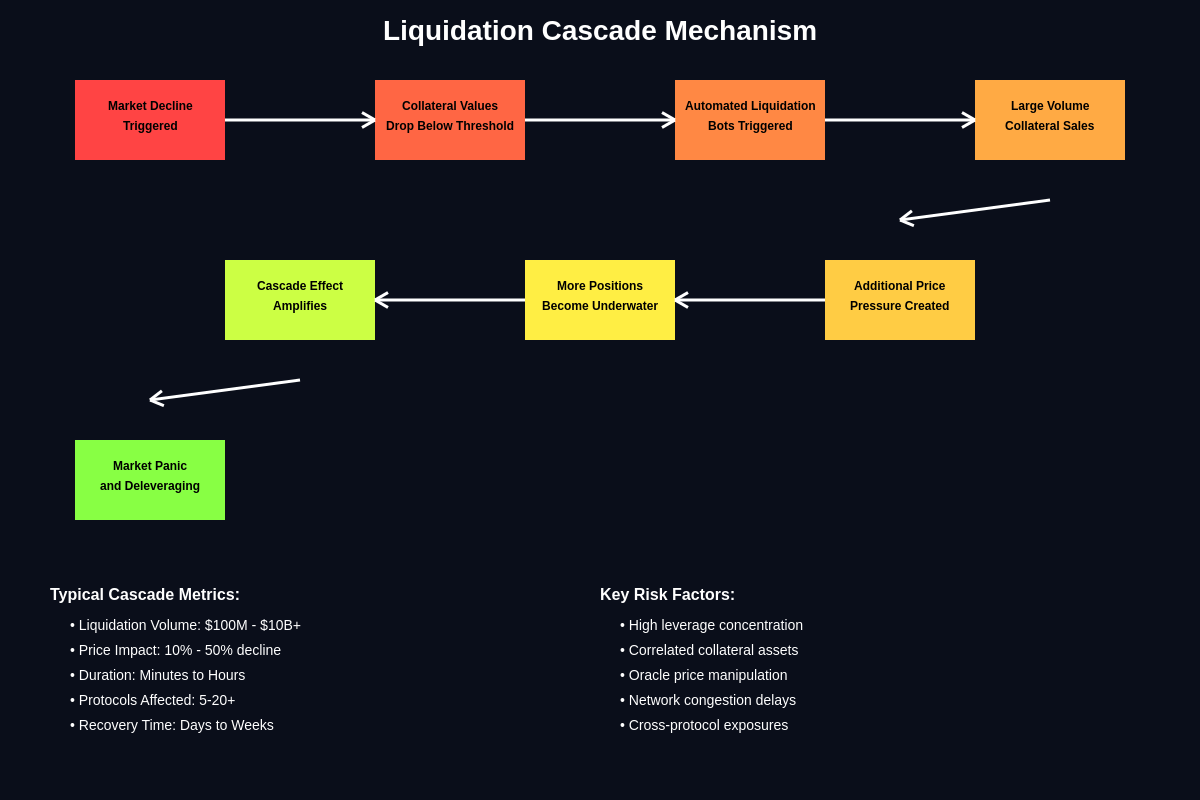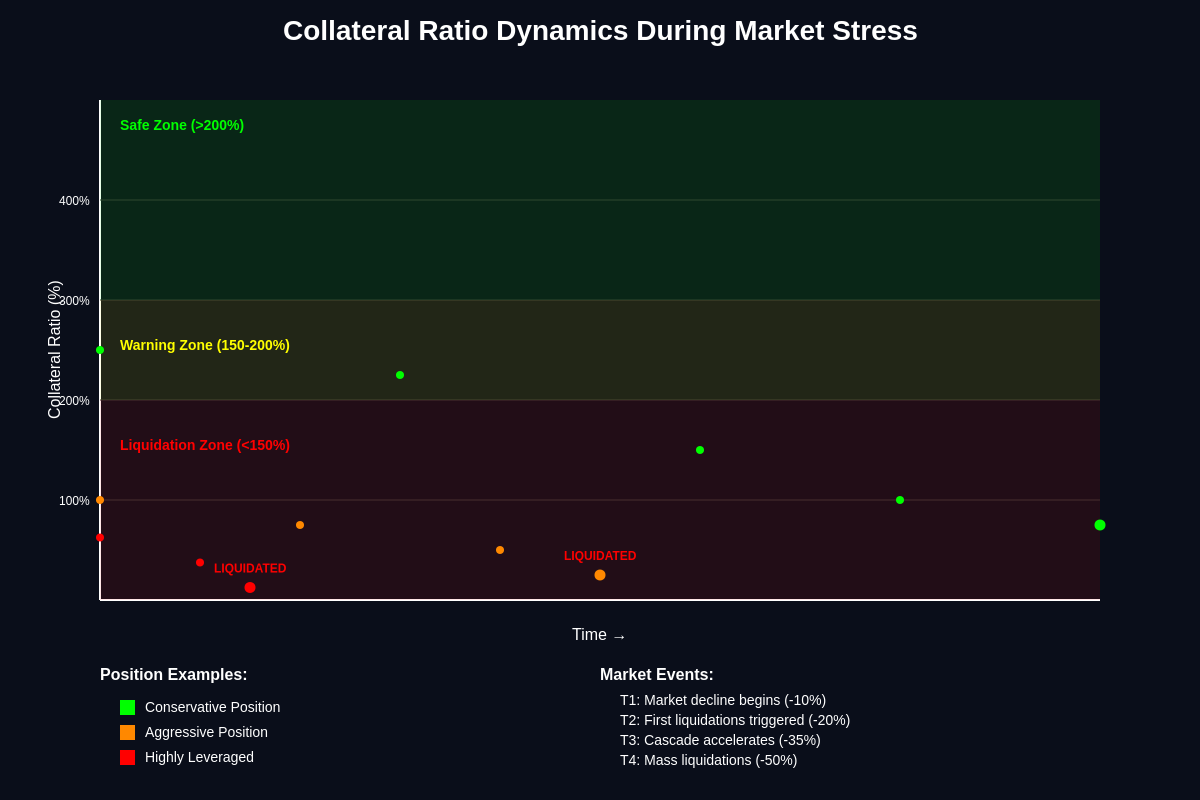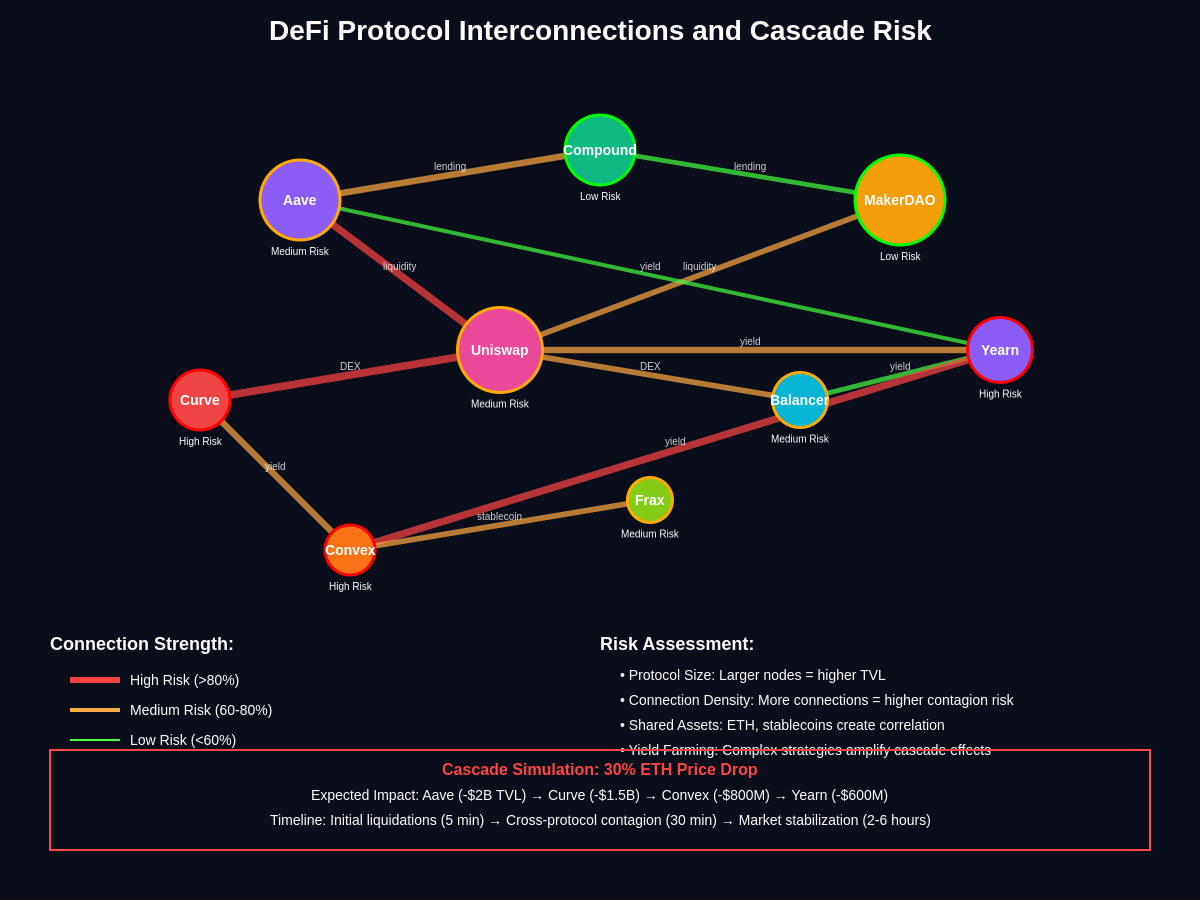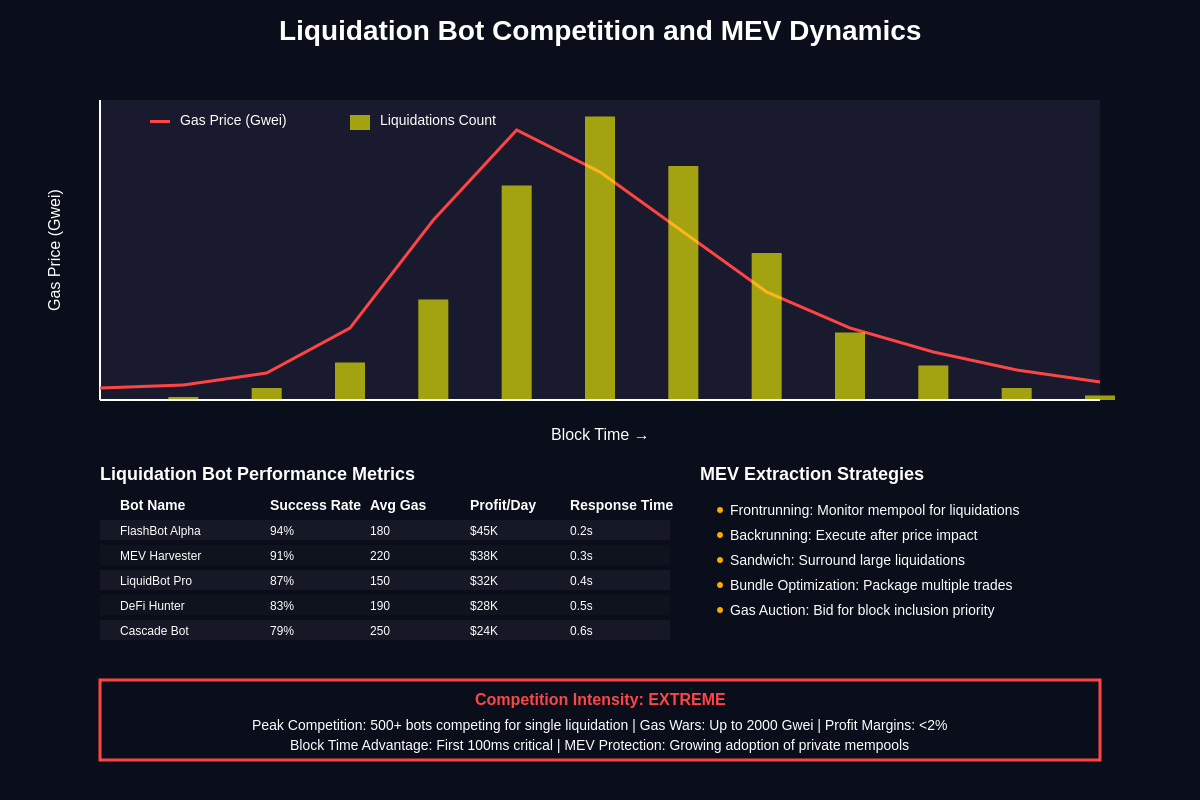The decentralized finance ecosystem has revolutionized traditional lending by enabling permissionless, algorithmic lending protocols that operate without intermediaries, yet this innovation has also introduced new systemic risks that can amplify market volatility through liquidation cascades. These events, where forced liquidations trigger subsequent liquidations in a domino effect, represent one of the most dangerous phenomena in DeFi, capable of turning moderate market corrections into catastrophic deleveraging events that can destabilize entire protocols and wipe out billions in value within hours. Understanding liquidation cascades requires examining the complex interplay between collateralized lending, automated liquidation mechanisms, oracle price feeds, and market microstructure in an environment where leverage can accumulate rapidly and transparently across interconnected protocols.
Track live liquidation data and DeFi metrics on TradingView
The Mechanics of DeFi Liquidations
DeFi lending protocols operate on the principle of overcollateralization, requiring borrowers to deposit assets worth significantly more than the value of their borrowed funds to ensure protocol solvency in the event of adverse price movements. When the value of collateral falls below predetermined thresholds relative to outstanding debt, automated liquidation mechanisms are triggered to protect the protocol and its lenders from insolvency. These liquidation thresholds, typically ranging from 125% to 200% depending on the specific protocol and asset volatility, create a buffer zone designed to ensure that collateral sales can cover outstanding debts even during periods of market stress.

The liquidation process itself involves sophisticated smart contracts that continuously monitor collateral ratios across all borrowing positions, automatically triggering liquidations when positions become undercollateralized. Liquidators, typically sophisticated traders or MEV bots, compete to execute these liquidations by repaying portions of the outstanding debt in exchange for purchasing the underlying collateral at a discount to market prices. This liquidation discount, usually ranging from 5% to 15%, provides economic incentives for liquidators while compensating for the risks and costs associated with rapid position closure.
However, the automated and competitive nature of DeFi liquidations can create feedback loops that amplify market volatility, particularly when large numbers of similar positions face liquidation simultaneously. Unlike traditional finance where liquidations might be handled discretionally by human operators who can consider market conditions and timing, DeFi liquidations execute mechanistically based purely on mathematical thresholds, potentially creating concentrated selling pressure that drives prices lower and triggers additional liquidations.
The speed and scale of modern DeFi liquidations have been dramatically enhanced by sophisticated MEV (Maximum Extractable Value) infrastructure that enables liquidators to identify and execute profitable liquidations within the same block that positions become eligible for liquidation. This efficiency, while beneficial for protocol security, can contribute to the rapid cascade effects that characterize major liquidation events.
Historical Liquidation Events and Market Impact
The DeFi ecosystem has experienced several major liquidation cascade events that have provided valuable insights into the systemic risks associated with decentralized lending protocols. The March 2020 market crash, often referred to as “Black Thursday,” demonstrated how traditional market stress could be amplified by DeFi liquidation mechanisms when MakerDAO experienced over $8 million in bad debt due to network congestion preventing timely liquidations. This event highlighted the critical importance of oracle accuracy, network capacity, and liquidation mechanism design in maintaining protocol stability during extreme market conditions.
More recent events have shown how the maturation and growth of DeFi has both increased the scale of potential liquidation cascades while also improving the resilience of individual protocols. The May 2021 market correction saw over $10 billion in liquidations across centralized and decentralized platforms within a 24-hour period, with DeFi protocols generally performing better than their centralized counterparts due to improved liquidation mechanisms and more conservative collateral requirements.
The Terra Luna collapse in May 2022 provided another stark example of how liquidation cascades can interact with broader ecosystem failures, as the depegging of UST triggered massive liquidations of LUNA collateral across multiple DeFi protocols. These liquidations created additional selling pressure that accelerated the collapse of the entire Terra ecosystem, demonstrating how DeFi liquidations can both respond to and contribute to systemic failures in interconnected protocols.
Analysis of LUNA price action during the collapse reveals how liquidation cascades can create non-linear price movements that exceed what might be expected from fundamental factors alone. The automated nature of DeFi liquidations, combined with the transparent and permissionless access to liquidation opportunities, can create intense competition among liquidators that results in rapid position closure and concentrated market impact.
Oracle Failures and Price Manipulation Risks
Oracle systems that provide price feeds to DeFi protocols represent critical infrastructure whose failure or manipulation can trigger inappropriate liquidations and cascade events. These systems face the challenging task of providing accurate, timely, and manipulation-resistant price information for a wide variety of assets, including newly launched tokens with limited liquidity and complex derivative instruments whose fair value may be difficult to determine.
Flash loan attacks targeting oracle systems have demonstrated how sophisticated attackers can temporarily manipulate reported prices to trigger liquidations of healthy positions, extracting value through artificially induced liquidation discounts. These attacks exploit the atomic nature of blockchain transactions, enabling attackers to manipulate prices, trigger liquidations, and restore original market conditions within a single transaction block.
The design of oracle systems significantly impacts liquidation cascade risk, with different approaches offering various trade-offs between accuracy, latency, and manipulation resistance. Time-weighted average price (TWAP) oracles provide resistance to short-term manipulation but may lag during periods of high volatility, potentially failing to trigger necessary liquidations until positions are severely undercollateralized. Conversely, spot price oracles offer greater responsiveness but increased vulnerability to manipulation and false liquidation triggers.
Chainlink’s decentralized oracle networks have become the standard for many DeFi protocols due to their resistance to single points of failure and manipulation, yet even these systems face challenges during periods of extreme volatility when rapid price movements can outpace oracle update frequencies. The emergence of oracle extractable value (OEV) as a concept highlights how the timing and accuracy of price updates can significantly impact liquidation outcomes and protocol economics.
Leverage Amplification in DeFi Ecosystems
The composable nature of DeFi protocols enables users to construct complex leveraged positions that span multiple protocols, creating leverage amplification effects that can contribute to severe liquidation cascades when market conditions deteriorate. Users can deposit assets as collateral in one protocol, borrow against that collateral, and then use the borrowed funds as collateral in another protocol to borrow additional funds, creating recursive leverage that can far exceed what would be available in traditional finance.

This leverage amplification is facilitated by the permissionless and programmable nature of DeFi, where smart contracts can automate complex multi-protocol strategies without requiring human oversight or approval. Yield farming strategies often involve multiple layers of leveraged positions designed to maximize returns on stablecoins or other assets, creating intricate webs of interdependent positions that can unravel rapidly during market stress.
The transparency of blockchain technology enables sophisticated analysis of leverage distribution across DeFi protocols, revealing concerning concentrations of similar positions that could trigger synchronized liquidations. Ethereum price movements often serve as the primary trigger for cascade events, as ETH frequently serves as collateral across multiple protocols, creating correlated liquidation risks.
Recursive borrowing strategies, where users borrow assets to purchase more of the same assets to use as additional collateral, create particularly dangerous liquidation dynamics. These strategies can generate impressive returns during favorable market conditions but face exponentially increasing liquidation risks as collateral values decline, often resulting in total position loss during moderate market corrections.
Protocol Design and Risk Management
The design choices made by DeFi lending protocols significantly impact their susceptibility to liquidation cascades and their ability to maintain stability during market stress. Conservative collateral requirements, while reducing leverage opportunities, provide greater buffers against liquidation cascades and protocol insolvency. Protocols like MakerDAO have historically maintained relatively conservative collateralization ratios, contributing to their stability during major market events.
Liquidation mechanisms themselves offer various design options that impact cascade dynamics, including the size of liquidation discounts, the portion of positions that can be liquidated in a single transaction, and the timing constraints on liquidation execution. Some protocols implement partial liquidation mechanisms that close only enough of a position to restore adequate collateralization, reducing the market impact of individual liquidations while maintaining protocol security.
Dynamic collateral requirements that adjust based on market volatility represent an emerging approach to liquidation cascade mitigation, enabling protocols to increase collateral requirements during periods of elevated risk while relaxing them during stable market conditions. These systems require sophisticated risk modeling and careful parameter tuning to avoid creating pro-cyclical effects that amplify volatility.
Insurance mechanisms and protocol-owned liquidity represent additional tools for managing liquidation cascade risks, providing protocols with resources to absorb losses from failed liquidations and maintain stability during extreme events. Protocols like Aave have implemented safety modules that provide backstop protection funded by protocol revenues and governance tokens, creating buffers against catastrophic liquidation events.
Cross-Protocol Contagion Effects
The interconnected nature of DeFi protocols creates pathways for liquidation cascades to spread across multiple platforms, amplifying initial market stress into ecosystem-wide deleveraging events. Users who maintain positions across multiple protocols may face simultaneous liquidations that exceed their ability to provide additional collateral, creating forced selling that impacts asset prices used as collateral in other protocols.

Shared collateral assets, particularly ETH and major DeFi tokens, create correlation channels through which liquidation cascades can propagate across seemingly independent protocols. When these assets face liquidation pressure in one protocol, the resulting price impact affects collateral values in all protocols using the same assets, potentially triggering additional liquidations in a self-reinforcing cycle.
Arbitrage relationships between protocols can also contribute to contagion effects, as arbitrageurs who maintain large positions across multiple platforms to capture small price differences may face simultaneous liquidations that impair their ability to provide liquidity and stabilize prices. The failure of major arbitrageurs during liquidation events can reduce market efficiency and increase the severity of price dislocations.
The emergence of protocol-to-protocol lending, where DeFi protocols themselves borrow from other protocols, introduces additional layers of systemic risk that can amplify liquidation cascades. These institutional-level borrowing relationships can create concentrated exposures that threaten multiple protocols simultaneously when market conditions deteriorate.
Regulatory Implications and Systemic Risk
Liquidation cascades in DeFi present complex challenges for financial regulators who are grappling with how to oversee decentralized systems that operate without traditional intermediaries or central points of control. The systemic risk posed by large-scale liquidation events extends beyond the immediate participants in DeFi protocols to impact broader cryptocurrency markets and potentially traditional financial markets as institutional adoption increases.
The automated and algorithmic nature of DeFi liquidations raises questions about market manipulation and fair trading practices, particularly when sophisticated actors use advanced strategies to trigger or profit from liquidation cascades. Regulatory frameworks designed for traditional finance may be inadequate for addressing the unique characteristics of decentralized liquidation mechanisms.
International coordination challenges arise from the global and permissionless nature of DeFi protocols, which can serve users from multiple jurisdictions simultaneously without regard to local regulations or restrictions. This creates potential regulatory arbitrage opportunities while complicating efforts to implement coordinated responses to systemic risks.
The classification of DeFi tokens and protocol governance mechanisms under existing securities laws remains uncertain in many jurisdictions, creating additional compliance challenges for protocols seeking to implement sophisticated risk management features that might require regulatory approval in traditional finance.
Technological Solutions and Innovations
Advances in blockchain technology and smart contract design are enabling new approaches to liquidation cascade mitigation that leverage the programmable nature of DeFi while addressing its inherent risks. Layer 2 scaling solutions are reducing the network congestion that can impair liquidation mechanisms during periods of high activity, enabling more reliable and timely position closure.

Automated market makers (AMMs) are being integrated with lending protocols to provide more efficient liquidation mechanisms that can reduce market impact by spreading liquidation sales across time and multiple venues. These integration approaches leverage the deep liquidity pools available in major AMMs while providing more sophisticated execution algorithms for liquidation events.
Machine learning applications are being developed to predict and prevent liquidation cascades through improved risk modeling and early warning systems. These systems analyze on-chain data patterns, market microstructure signals, and cross-protocol dependencies to identify potential cascade triggers before they materialize.
Zero-knowledge proof systems offer potential solutions for creating more sophisticated liquidation mechanisms that can consider private information about user positions and risk tolerance while maintaining the transparency and auditability required for decentralized protocols.
Economic Analysis and Market Efficiency
The economic efficiency of DeFi liquidation mechanisms represents a complex trade-off between protocol security, market stability, and capital efficiency. While liquidation cascades can create significant short-term disruptions, they also serve important functions in price discovery and risk management that contribute to long-term market efficiency.
The competitive liquidation environment in DeFi, where multiple sophisticated actors compete to execute profitable liquidations, generally ensures efficient price discovery and rapid position closure. However, this efficiency can come at the cost of increased volatility and cascade risk, particularly when liquidation opportunities are concentrated in time or across similar positions.
Capital efficiency analysis reveals how liquidation cascade risks impact the optimal design of DeFi protocols, influencing decisions about collateral requirements, liquidation thresholds, and supported assets. Protocols must balance the desire to offer competitive leverage ratios with the need to maintain adequate safety buffers against cascade events.
The emergence of liquidation insurance and protection products represents a market-based approach to managing cascade risks, enabling users to purchase protection against liquidation events while providing new revenue opportunities for sophisticated risk managers. These products demonstrate how DeFi’s composability enables innovative risk management solutions that would be difficult to implement in traditional finance.
User Education and Risk Management Strategies
The complexity of DeFi liquidation mechanisms and cascade risks presents significant challenges for user education and risk management, particularly as these platforms attract users who may lack sophisticated understanding of the underlying risks. Educational initiatives must address not only the basic mechanics of lending and liquidation but also the systemic risks associated with leverage amplification and cross-protocol exposures.
Risk management strategies for DeFi users include position sizing techniques that account for liquidation cascade risks, diversification across multiple protocols and collateral types, and active monitoring of collateral ratios and market conditions. Advanced users employ sophisticated hedging strategies using derivatives and options to protect against liquidation events while maintaining leveraged exposure to desired assets.
The development of user-friendly risk management tools represents an important area for DeFi infrastructure development, enabling less sophisticated users to participate safely in leveraged DeFi strategies. These tools include automated position management systems, liquidation protection services, and risk analytics platforms that provide real-time assessment of liquidation vulnerabilities.
Community-driven education efforts have emerged as important resources for DeFi risk management, with experienced users sharing strategies and lessons learned from managing positions through various market cycles and liquidation events. These educational resources demonstrate how decentralized communities can develop effective risk management practices without traditional institutional oversight.
Future Evolution and Emerging Trends
The future evolution of DeFi liquidation mechanisms is likely to incorporate more sophisticated risk management features that leverage advances in blockchain technology, financial engineering, and data analytics. Cross-chain lending protocols are enabling new forms of liquidation cascade risks while also providing opportunities for better risk diversification across multiple blockchain ecosystems.
Artificial intelligence applications in liquidation prediction and prevention represent an emerging trend that could significantly reduce cascade risks through improved early warning systems and automated risk management. These systems leverage the transparent nature of blockchain data to develop sophisticated models of liquidation cascade dynamics and user behavior patterns.
The integration of traditional finance risk management practices with DeFi protocols is creating hybrid systems that combine the efficiency and transparency of decentralized systems with the stability and risk controls of traditional finance. These developments may lead to more stable DeFi ecosystems while maintaining the innovation and accessibility that characterize decentralized finance.
Governance evolution in DeFi protocols is enabling more sophisticated and responsive risk management practices, with communities developing better processes for adjusting protocol parameters in response to changing market conditions and emerging risks. These governance improvements demonstrate how decentralized communities can develop effective risk management practices through trial and learning.
Advanced DeFi analytics and liquidation monitoring tools continue to evolve on TradingView
The ongoing development of liquidation cascade mitigation strategies represents a critical area for DeFi protocol development, with new approaches continuously emerging to address the complex challenges associated with maintaining stability in permissionless, algorithmic lending systems. These developments will likely determine the long-term viability and adoption of DeFi lending protocols as they mature and face increasing scrutiny from regulators and institutional participants.
As the DeFi ecosystem continues to evolve, the lessons learned from liquidation cascade events will inform the development of more robust and resilient protocols that can provide the benefits of decentralized lending while managing the systemic risks that threaten ecosystem stability. The success of these efforts will largely determine whether DeFi can achieve mainstream adoption while maintaining the innovative characteristics that distinguish it from traditional finance.
Disclaimer: This article is for informational purposes only and does not constitute financial advice. Cryptocurrency investments and DeFi protocols involve substantial risks, including the potential for total loss of capital. Liquidation cascades represent complex systemic risks that can result in rapid and significant losses. Readers should conduct their own research and consult with qualified financial advisors before participating in DeFi lending protocols or leveraged cryptocurrency strategies. The volatile and experimental nature of DeFi technologies means that protocols may contain bugs, vulnerabilities, or design flaws that could result in loss of funds. Past performance does not guarantee future results, and the regulatory status of DeFi protocols remains uncertain in many jurisdictions.